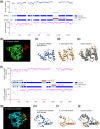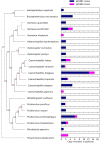DNA Polymerase Diversity Reveals Multiple Incursions of Polintons During Nematode Evolution
- PMID: 38069639
- PMCID: PMC10748475
- DOI: 10.1093/molbev/msad274
DNA Polymerase Diversity Reveals Multiple Incursions of Polintons During Nematode Evolution
Abstract
Polintons are double-stranded DNA, virus-like self-synthesizing transposons widely found in eukaryotic genomes. Recent metagenomic discoveries of Polinton-like viruses are consistent with the hypothesis that Polintons invade eukaryotic host genomes through infectious viral particles. Nematode genomes contain multiple copies of Polintons and provide an opportunity to explore the natural distribution and evolution of Polintons during this process. We performed an extensive search of Polintons across nematode genomes, identifying multiple full-length Polinton copies in several species. We provide evidence of both ancient Polinton integrations and recent mobility in strains of the same nematode species. In addition to the major nematode Polinton family, we identified a group of Polintons that are overall closely related to the major family but encode a distinct protein-primed DNA polymerase B (pPolB) that is related to homologs from a different group of Polintons present outside of the Nematoda. Phylogenetic analyses on the pPolBs support the evolutionary scenarios in which these extrinsic pPolBs that seem to derive from Polinton families present in oomycetes and molluscs replaced the canonical pPolB in subsets of Polintons found in terrestrial and marine nematodes, respectively, suggesting interphylum horizontal gene transfers. The pPolBs of the terrestrial nematode and oomycete Polintons share a unique feature, an insertion of an HNH nuclease domain, whereas the pPolBs in the marine nematode Polintons share an insertion of a VSR nuclease domain with marine mollusc pPolBs. We hypothesize that horizontal gene transfer occurs among Polintons from widely different but cohabiting hosts.
Keywords: DNA polymerase; Polinton/Maverick; dsDNA virus; horizontal gene transfer; nematode; transposon.
© The Author(s) 2023. Published by Oxford University Press on behalf of Society for Molecular Biology and Evolution.
Figures






Update of
-
DNA polymerase diversity reveals multiple incursions of Polintons during nematode evolution.bioRxiv [Preprint]. 2023 Aug 24:2023.08.22.554363. doi: 10.1101/2023.08.22.554363. bioRxiv. 2023. Update in: Mol Biol Evol. 2023 Dec 1;40(12):msad274. doi: 10.1093/molbev/msad274. PMID: 37662302 Free PMC article. Updated. Preprint.
References
-
- Ahmed M, Roberts NG, Adediran F, Smythe AB, Kocot KM, Holovachov O. Phylogenomic analysis of the phylum Nematoda: conflicts and congruences with morphology, 18S rRNA, and mitogenomes. Front Ecol Evol. 2022:9:769565. 10.3389/fevo.2021.769565. - DOI
MeSH terms
Substances
Grants and funding
LinkOut - more resources
Full Text Sources

